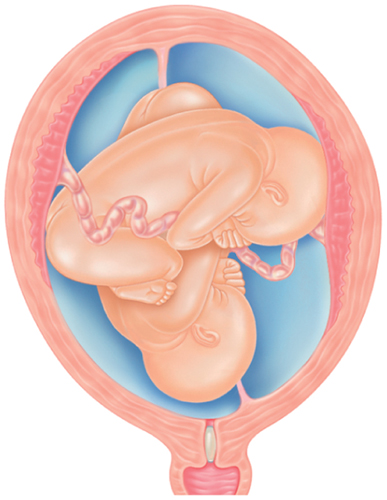You are 30 Weeks and 3 Days 67 days to go…
Natural birth has many advocates, but the best birth is one that delivers your baby safely with minimum trauma for both of you.
Your baby today
It can come as quite a surprise to see that your baby will be
increasingly making all sorts of expressions. Here the baby had his
mouth turned down but the next minute will be yawning, grimacing, or
peacefully sleeping.
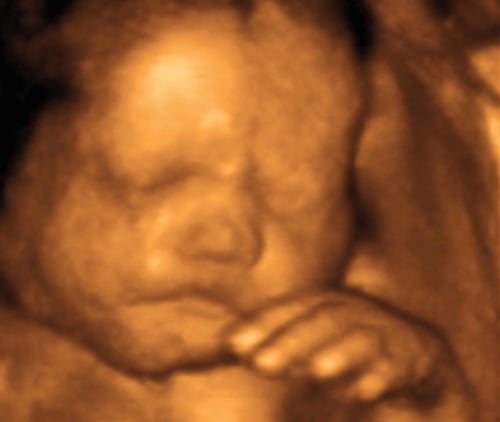
Many women want a natural delivery,
with no pain relief or other medical intervention. Giving birth
naturally is for some reason perceived as the “best” way, and to do
otherwise means that you somehow “failed” at childbirth. This pressure
means that women can feel guilty or even depressed if they needed pain
relief or a cesarean section, for example.
Bear in mind that
some women have higher pain thresholds and can get through labor with
simple breathing or relaxation techniques, while others need more help.
Pain is subjective, no one else can feel your pain; if it is too much
for you, then ask for help. Your options will be explained to you by the doctor.
Childbirth is hard
work, but the experience should not be so painful that it scars you.
Being pain-free may mean that you have a more enjoyable, even
empowering, labor experience. If you do decide you want pain relief, an
epidural is the most common option—more than half of women having a baby
in a hospital receive one.
… Natural birth
| Q: |
I want a natural birth but everyone says I’ll change my mind once I’m in labor. Are they right?
|
| A: |
Mom:
Nothing can prepare you for the discomfort of labor, and I found my
carefully laid plans were unrealistic and impractical when the pain
kicked in. No matter how well prepared you are, you may change your mind
during labor, and it’s worth being prepared for that. I did feel a bit
disappointed that I couldn’t manage without pain relief. It helps if you
focus on what’s important—delivering a healthy baby. If you achieve
this aim, you’ve succeeded, no matter what happens along the way. I
would say to stick it out for as long as you can, but you’ll be doing
yourself and your baby no favors if you both become exhausted and
distressed.
Doctor:
Many women are shocked by the intensity of the birth experience, and
soon forget about their idealistic birth plan. It’s better for all
involved that you allow for contingency plans, and keep an open mind.
Pain relief and interventions are designed to make the experience better for you
and your baby, and will not be offered unless they’re necessary, or you
feel that you can’t do without them. Some women get through labor
naturally; others need some help. A lot of women do change their mind
about “going natural,” and there is nothing wrong with that. A mom who
has her pain under control will find that the delivery is much quicker,
and she’ll have much more energy for her new arrival.
|
Having a natural birth
is high on the list of many women’s priorities, but it’s a good idea to
prepare mentally for medical intervention, in case it becomes
necessary.

Twins
Just a few weeks to go. By
now, you’re probably quite large and, of course, excited at the imminent
arrival of your twins, or more. However, you may also be concerned
about how you will manage during and after the birth.
Getting ready for the birth
Although multiple
pregnancies and births are more likely to have complications, they are
now safer than ever as advances in prenatal and postpartum care have
dramatically improved the outlook for premature babies—the main concern
with multiples (see How your babies lie in the uterus).
You can prepare for
the birth by getting plenty of rest. Putting your feet up, or even
having a nap during the day, helps improve the blood flow to the
placenta, which in turn helps your babies grow. Practicing Kegel
exercises is important with a multiple pregnancy since your pelvic floor muscles are under additional strain.
A shorter pregnancy
Twins or more
usually arrive earlier than singletons. Space in the uterus is one
factor. In addition, with multiple pregnancies the placenta becomes less
efficient toward the end of pregnancy. As a result, the average length
of pregnancy is shorter: for twins 36 to 37 weeks is considered typical,
for triplets the average pregnancy is 33 weeks, and for quadruplets
pregnancy lasts about 30 weeks. The average birth weight for each twin
is 5 lb 8 oz (2.5 kg) at full term.
You may deliver even
earlier than this, since nearly 50 percent of twins are born
prematurely. However, nowadays expert care for premature babies means
that about 75 percent of babies weighing 3 lb 5 oz at birth, and 57
percent of babies weighing 2 lb 3 oz at birth, survive.
Preparing for more than one
Even if your twins are
identical they’re individuals, and relating to them as separate people
will help their development and your relationship with them. Even in
pregnancy, some expectant moms notice how different their babies are
from their different movement patterns in the uterus.
Thinking ahead
Bonding with twins
Often, expectant moms of twins or more
worry about how they will bond with more than one baby. It’s true that
bonding can be harder with twins, and even more so with higher
multiples. After all, it’s hard to fall in love with more than one
person at a time, especially when you’re exhausted caring for two babies
or more. Being aware of this and arranging extra help for after the
birth may ease your anxiety. Also, accept additional offers of help that
allow you to rest or spend time with one twin. If someone offers to
take the twins out, you might consider one twin going and the other
spending time with you.
How your babies lie in the uterus
In the final weeks, your babies will take up their positions for the birth.
The most common position is with both babies lying vertically. With 75
percent of twins, the first is head down (cephalic); the second twin may
be head down or breech, or one twin may lie across the uterus
(transverse). You may suspect their position from the kicks, but only a
scan confirms this.
A cesarean will be
recommended if you have triplets or more, or your first twin is breech
or transverse (25 percent of cases). A vaginal delivery is most likely
if both twins are head down. If the first is head down and the second is
transverse or breech, there are different opinions as to the best type
of delivery, which you can discuss with your obstetrician.
Both babies head down (cephalic)
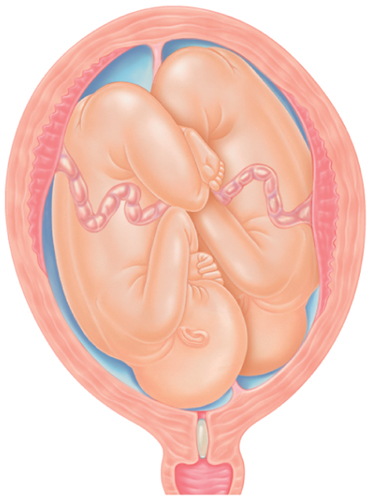
One baby head down, and one breech
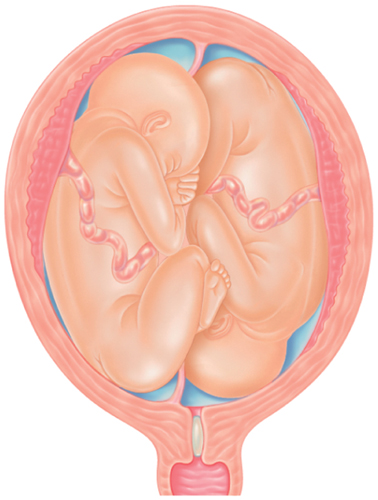
Both babies in a breech position
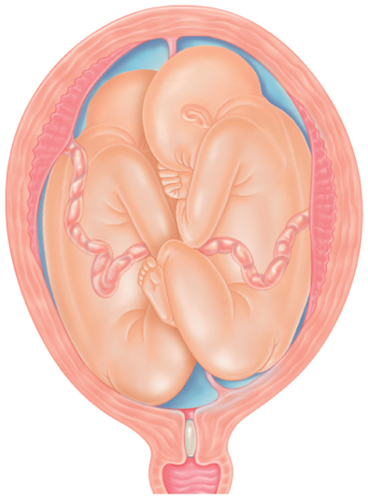
One baby head down and one transverse
